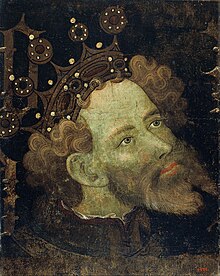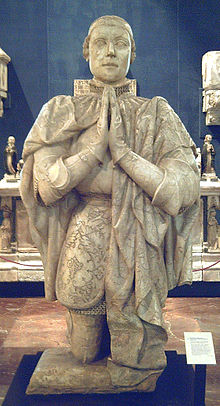War of the Two Peters
| War of the Two Peters | |||||||
|---|---|---|---|---|---|---|---|
| Part of the Hundred Years' War | |||||||
| |||||||
| Belligerents | |||||||
|
With the support of: |
With the support of: | ||||||
| Commanders and leaders | |||||||
|
|
| ||||||
The War of the Two Peters (Spanish: La Guerra de los Dos Pedros, Catalan: Guerra dels dos Peres) was fought from 1356 to 1375 between the crowns of Castile and Aragon. The conflict was a struggle between two claimants to the throne of Castile, Peter of Castile and Peter IV of Aragon. The former Peter was supported by England and several English nobles led by Edward III and his son, while the latter Peter was supported by France. The conflict also brought in the involvement of the kingdoms of Navarre and Portugal. The war resulted in Aragon gaining the upper hand, but it also devastated its economy that was already reeling from the effects of the Black Death.
Background


At the beginning of the fourteenth century, Castile was suffering from unrest caused by its civil war, which was fought between the local and allied forces of the reigning king, Peter of Castile, and his half-brother Henry of Trastámara over the right to the crown.
Peter IV of Aragon supported Henry of Trastámara. Henry was also supported by the French commander Bertrand du Guesclin and his "free companies" of troops. Peter of Castile was supported by the English. The War of the Two Peters can thus be considered an extension of the wider Hundred Years' War as well as the Castilian Civil War.
Peter of Castile sought to claim the
A naval incident between the two powers had already caused tension:
War
1356–1363
The war lasted from 1356 to 1375, prolonged because Peter of Castile lost his throne to Henry of Trastámara. The war primarily took place on the border between Castile and Aragon, namely Aragonese border towns such as Teruel, which fell to the Castilians.
In 1357, Castile penetrated Aragon and conquered Tarazona on March 9; on May 8, they arranged a temporary truce.
At the beginning of 1361, the Castilians conquered the fortresses of
In June 1362, Peter of Castile met with
With these negotiations complete, the Castilian king invaded Aragonese territory without officially declaring war, and the conflict commenced again. The Aragonese king was at
In 1363, Castile continued the war against Aragon, and again occupied Tarazona. Peter of Castile received reinforcements from
The
1363–1369
From 1365 to 1369, Peter of Castile was preoccupied with maintaining his position on the Castilian throne against Henry of Trastámara.
The
Peter of Castile was overthrown in 1369. He was killed by Henry.[3]
Invasion of Valencia
The
End of the war

Castile recovered comarcas that had passed under Aragonese rule, such as the lordship of Molina. A marriage was contracted between Eleanor of Aragon, daughter of Peter IV of Aragon, and John I of Castile, the successor of Henry II of Castile.
The misery of the war was compounded by the
However, the war is believed to have led to the establishment of administrative and military forces that would ultimately result in a unified Castile and Aragon in the next century.[7]
References
- ^ [1] Archived June 9, 2007, at the Wayback Machine
- ^ "1360 - 1365". Uv.es. Retrieved 2015-05-31.
- ^ "Guerra de los dos Pedros (1356-1369) - Página de voz - Gran Enciclopedia Aragonesa OnLine". Enciclopedia-aragonesa.com. Retrieved 2015-05-31.
- ^ "Villalon and Kagay - The Hundred Years War: A Wider Focus". Deremilitari.org. Retrieved 2015-05-31.
- ^ "If these walls could talk". Thinkspain.com. Retrieved 2015-05-31.
- ^ [2] Archived December 21, 2007, at the Wayback Machine
- ^ Donald J. Kagay, "The Defense of the Crown of Aragon during the War of the Two Pedros (1356-1366)," The Journal of Military History, Volume 71, Number 1, January 2007, pp. 11-31.
Bibliography
- Kagay, Donald J. (2007). "The Defense of the Crown of Aragon during the War of the Two Pedros (1356–1366)". The Journal of Military History. 71 (1): 11–31. S2CID 201755047. [A later version of this paper appears in Villalon and Kagay (eds.), The Hundred Years War (Part II).])
{{cite journal}}: CS1 maint: postscript (link - Kagay, Donald J. (2012). "The War of the Two Pedros (1356–1366): Aragon's Successful Administrative Strategy of Asymmetrical Defense". Imago Temporis: Medium Aevum. 6: 191–222.
- Kagay, Donald J. (2013). "Disposable Alliances: Aragon and Castille during the War of the Two Pedros and Beyond". Studies in Medieval and Renaissance History. 10: 111–47. [A working version of this paper is available here.]
{{cite journal}}: External link in|postscript= - Villalon, L. J. Andrew (2008). ""Cut Off Their Heads, or I'll Cut Off Yours": Castilian Strategy and Tactics in the War of the Two Pedros and the Supporting Evidence from Murcia". In L. J. Andrew Villalon; Donald J. Kagay (eds.). The Hundred Years War (Part II): Different Vistas. Leiden: Brill. pp. 153–84.
